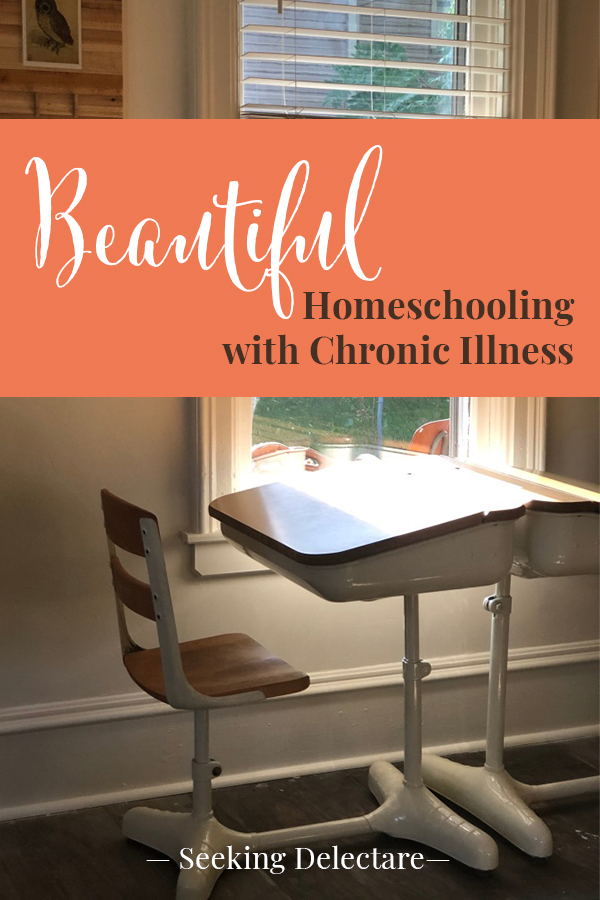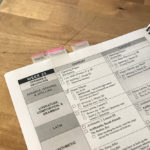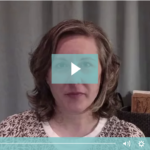
*This post contains affiliate links for Memoria Press products. No other affiliate links are present. All opinions are my own.
When you’re homeschooling with chronic illness, everyone says to use read-alouds, videos, and your children’s interests to get through the school day. It’s similar to the idea that “the best curriculum is the one that gets done.”
But as a chronically ill homeschooling mom, I want to push back on that advice; because we can give our children a deeper, richer education.
I’ve posted before about how we order our homeschool, prioritizing Faith, Latin, and math. Faith orders our souls, Latin orders language and math orders the sciences.
After these, we practice the skills of the liberal arts in the context of literature, history, and science.
But we don’t do all of these things formally, and some are simply on the back burner for now.
Learning to Trust
In Teaching from Rest, Sarah MacKenzie says it’s our job to “bring our basket” and let God multiply the loaves and fishes.
I don’t have much in my basket, but I’m trying to remember that I can offer what I do have to Our Lord:
- Morning time: a Cultivating the Virtues online lesson with reflection time
- 5 year old: one or two pages each in her alphabet and numbers books
- 8 year old with special needs: phonics, reading, and spelling
- 9 year old: Latin and literature (she’s a natural speller)
- 11 year old with special needs: Latin, spelling, and literature
- 13 year old: Latin and literature with me, composition and science online
- Everyone: CTCMath online
My high schoolers are mostly independent, using a combination of live, recorded, and streaming classes. I answer questions and review work as needed, and I check their planners once a week to make sure they’re on track.
This is a far cry from what I planned.
Yet my children are still receiving a rich education. They’re growing in their Faith, developing a deeper understanding of the order and structure of language, building stronger foundations in arithmetic, and gaining a deeper understanding of human nature through beautiful literature.
But how?
Tips for Homeschooling with Chronic Illness
Take each day for what it is
I often get only 3-4 hours of normal energy a day; but there are five children (and laundry!) to fit within that time frame.
So I have to accept that what we get done is what we get done. The next day we simply start again.
Combine where possible
While I don’t think it’s wise to combine children in skill subjects, but I do combine them for Scripture and catechism. When we’re able to pick up history and science again, I’ll likely combine my 10 and 12 year olds in those as well.
Keep things simple
I love creative projects, but I don’t love it when our learning depends on them
This is one of the things I appreciate about our curriculum.
It opens the door for rabbit trails and projects, but it keeps them as optional, nice-if-we-can-get-to-it things; they’re not essential to the lessons.
Work one-on-one for skill subjects
After Morning Time, I work with each child one-on-one. This lets me focus my mental energy on one person, and one subject, at a time.
This one-on-one time looks different depending on each child’s level of independence:
- 5 year old: completely at-elbow
- 8 year old: completely at-elbow
- 9 year old: lessons during one-on-one time. I then write down the related assignments and she does those independently
- 11 year old: a mix of lessons, independent, and at-elbow work
- 13 year old: like the 9 year old and we outsourced his two most difficult classes this year
Focus on the good things
Even with these tips, there’s usually one week a month when we aren’t able to do much schooling. Some days we only get to Morning Time.
But here’s what God is doing with this meager basket:
- My 9 year old has completed Unit 1 in First Form Latin and excelled in every lesson
- My 9 and 11 year olds take our American history read-alouds off the shelf and read them on their own. They’ve re-read them multiple times now.
- My 8 year old kept looking at books every day and, without me knowing, turned it into practice time. After four years of learning to read, she’s now reading at a first grade level.
- My 13 year old took ownership of his school progress.
Choosing the Right Path
Our dear priest says that God expects us to do what we reasonably/morally can to alleviate our suffering. What’s left over is what we’re actually called to carry.
The reasonable things we do to manage our symptoms don’t detract from serving our families — they enable us to continue serving them.
To manage my symptoms, I had to pull back to essentials, but that allowed God to work. As St. Paul says:
“Three times I begged the Lord about this, that it might leave me, but he said to me, ‘My grace is sufficient for you, for power is made perfect in weakness.'”
2 Corinthians 12:8-9
This doesn’t give us permission to take the easiest path possible, but it reminds us to work within our legitimate limits.
Homeschooling with chronic illness isn’t easy; but we can follow the path more slowly, trusting God to carry us when even small steps are too much.




Jennifer,
These words are music to my ears. Truly this wisdom and grace from God will benefit so many others who are struggling whether that be from chronic illness or even just overwhelm in general. We are about to make another big move back to our home state. This was not part of my plan! However, I think this post helps me to realize we can do this with God’s help and figure out our priorities and trust that God will handle the rest. Thank you for some much needed comfort. I am so glad to call you friend! Blessings to your family.